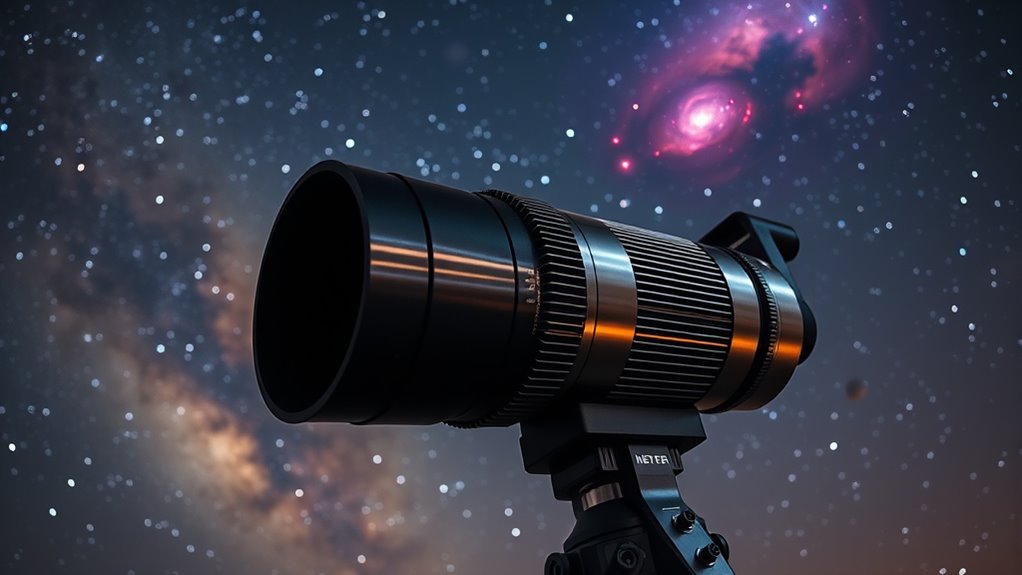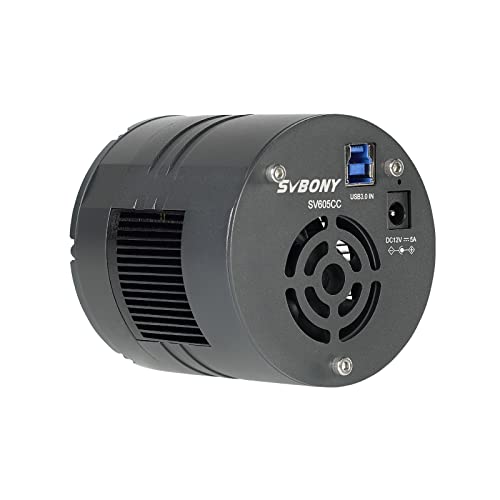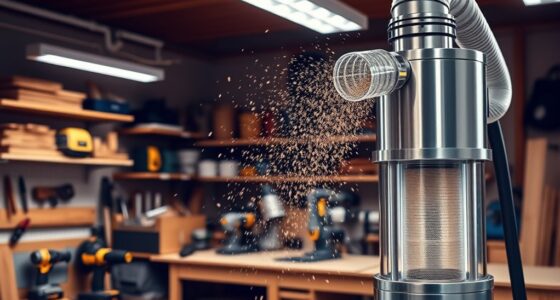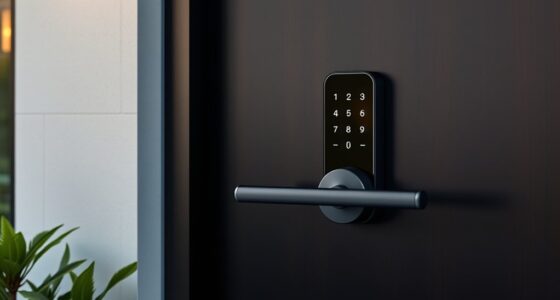If you’re looking for the best cooled CMOS astro cameras for deep sky imaging in 2025, I recommend the SVBONY SV605CC for its high-resolution sensor and effective cooling system that reduces noise during long exposures. The Astromania SGCMOS also stands out with its high sensitivity and suitable long exposure capabilities. Both models offer strong durability and compatibility with various setups. Keep exploring these options to find the perfect fit for your astrophotography needs.
Key Takeaways
- The SVBONY SV605CC offers high-resolution imaging with advanced cooling for minimal noise during long exposures.
- The Astromania SGCMOS provides strong sensitivity and long exposure capabilities suitable for capturing faint deep-sky objects.
- Both cameras feature effective cooling systems that significantly reduce thermal noise, ensuring high image quality.
- Compatibility with multiple operating systems and stable software support enhances ease of use for astrophotographers.
- Designed for outdoor durability, these models are weather-resistant and built to perform reliably in various environmental conditions.
SVBONY SV605CC Cooled Camera, 9MP CMOS Telescope Camera
If you’re serious about deep sky astrophotography, the SVBONY SV605CC cooled camera is a great choice because it combines a high-resolution 9MP CMOS sensor with effective cooling technology. Its square IMX533 chip offers 3008×3008 resolution and 80% quantum efficiency, ensuring sharp, detailed images. The double-layer TEC cooling system lowers sensor temperature by up to 30°C below ambient, reducing noise and glow. Compatible with Windows, Linux, Mac OS, and even Raspberry Pi, it’s versatile for indoor or outdoor use. Lightweight and compact, it’s easy to mount on various telescopes. Overall, it’s a budget-friendly option that delivers impressive deep sky images with proper setup.
Best For: amateur and semi-professional astrophotographers seeking a high-resolution, cooled CMOS camera for deep sky imaging on various platforms including Windows, Linux, Mac OS, and Raspberry Pi.
Pros:
- High-resolution 9MP CMOS sensor with 3008×3008 pixels and 80% quantum efficiency for detailed imaging
- Effective TEC cooling system that reduces sensor temperature by up to 30°C below ambient, minimizing noise and glow
- Compatible with multiple operating systems and telescope mounts, offering versatile indoor and outdoor use
Cons:
- Inconsistent cooling performance and potential noise issues such as horizontal banding and frame drops
- Fan operation can be loud and distracting during use
- Some users experience reliability and support challenges, requiring troubleshooting and calibration
Astromania SGCMOS Series Telescope CMOS Camera
The Astromania SGCMOS Series Telescope CMOS Camera stands out as an excellent choice for amateur astronomers seeking affordable yet capable guiding and imaging equipment. It features a high-sensitivity sensor with fast frame rates and long exposure capabilities, ideal for auto-guiding and deep-sky imaging. Its aluminum CNC housing ensures durability, and the 1.25-inch interface allows for easy integration with eyepieces and filters. The built-in ST4 guider port simplifies guiding setups, while dedicated software supports video preview, recording, and image processing. Although it has some driver and sensitivity limitations, its affordability and versatility make it a popular entry-level option for astrophotographers.
Best For: amateur astronomers and astrophotographers seeking an affordable, easy-to-use guiding and imaging camera for deep-sky and planetary observations.
Pros:
- High-sensitivity sensor with fast frame rates and long exposure capabilities suitable for guiding and astrophotography
- Durable aluminum CNC housing with standard 1.25-inch interface for easy integration with telescopes and filters
- Built-in ST4 guider port and dedicated software support for video preview, recording, and image processing
Cons:
- Limited driver support and issues with driver signing on Windows 10/11, which can cause setup difficulties
- Moderate sensitivity requiring longer exposures compared to premium cameras, limiting imaging of very faint objects
- Compatibility issues and limited support for Mac OS and Linux, along with some hardware and driver stability concerns
Factors to Consider When Choosing Cooled CMOS Astro Cameras for Deep Sky Imaging
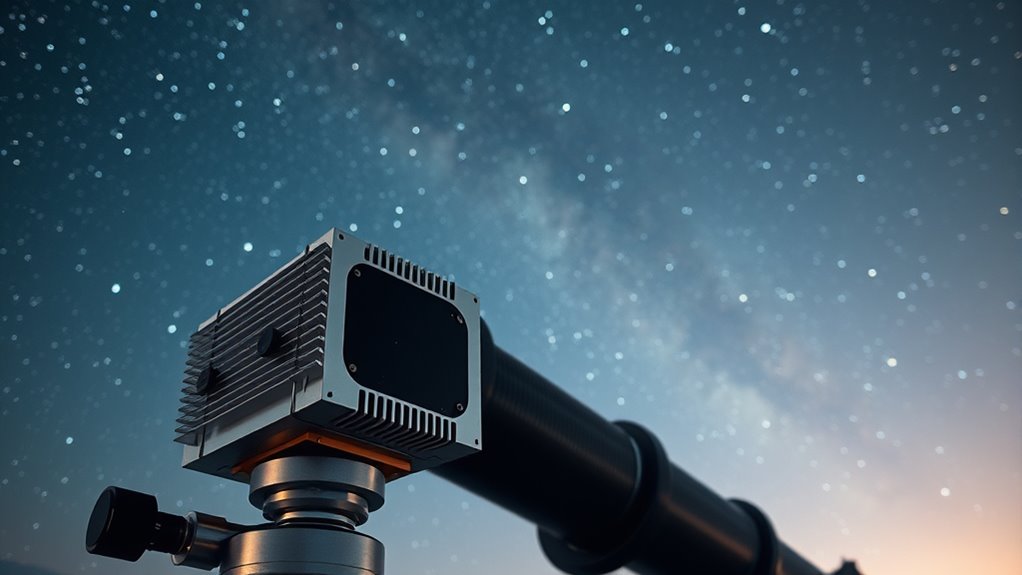
When selecting a cooled CMOS astro camera for deep sky imaging, I focus on several key factors. These include sensor sensitivity and quantum efficiency, cooling performance to minimize noise, and compatibility with my existing equipment. Understanding these points helps me choose a camera that delivers high-quality images and reliable operation.
Sensor Sensitivity and QE
Have you ever wondered what makes a cooled CMOS astro camera so effective for deep sky imaging? It all comes down to sensor sensitivity and Quantum Efficiency (QE). QE measures how well a sensor converts incoming photons into electrons; higher QE means better sensitivity. Many cooled CMOS cameras boast QE rates over 80%, allowing me to capture faint objects with shorter exposures and better signal-to-noise ratios. The spectral response also matters since some sensors are optimized for specific wavelengths like near-infrared or visible light, enhancing their effectiveness. Variations in QE across the sensor surface can affect image uniformity, so high-QE sensors help produce consistent, high-quality images. Ultimately, better QE translates directly into more detailed, vibrant astrophotos with less effort.
Cooling Efficiency and Noise
Choosing a cooled CMOS astro camera hinges on its cooling efficiency because effective cooling directly reduces thermal noise that can obscure faint celestial details. TEC systems typically lower sensor temperatures by 20-30°C below ambient, which considerably decreases dark current—the main source of noise in long exposures. Lower dark current means cleaner images with better contrast and detail. However, if cooling isn’t effective, residual thermal noise persists, diminishing image quality. The quality of the cooling system matters; poorly designed or underpowered TEC modules can cause inconsistent temperatures and increased noise. External factors like ambient temperature and airflow also influence cooling performance. Proper thermal management ensures the sensor stays at ideal temperatures, reducing noise and maximizing the camera’s imaging potential for deep sky astrophotography.
Compatibility With Equipment
Selecting a cooled CMOS astro camera that fits seamlessly into your existing setup requires careful attention to compatibility factors. First, verify the camera’s mounting options, like T-ring, C-mount, or 1.25-inch interfaces, match your telescope or guiding equipment. Next, check if it supports standard connection ports such as USB 2.0, USB 3.0, or Wi-Fi, so you can connect easily with your computer or remote systems. Compatibility with your operating system is essential; verify driver support for Windows, Linux, or Mac OS, and compatibility with astronomy software like SharpCap or ASCOM. Also, consider the sensor size, resolution, and pixel dimensions to match your imaging needs and optics. Finally, verify the cooling system and power requirements align with your setup’s power sources and environmental conditions.
Image Quality and Resolution
Ever wondered how to guarantee your deep sky images are crisp and detailed? The key lies in choosing a camera with high resolution, like a 9MP CMOS sensor, which captures finer details. Pixel size and sensor dimensions substantially affect your ability to resolve faint objects and reduce noise; larger sensors generally perform better in this regard. Quantum efficiency plays an important role, as higher efficiency means more light is captured, resulting in brighter, more detailed images. Cooled CMOS cameras help minimize thermal noise during long exposures, ensuring sharper results. Consistent focus and minimal artifacts like banding or noise are vital for maintaining image clarity over extended sessions. Prioritizing these factors ensures your astrophotos will be both vibrant and precise.
Software and Driver Support
When evaluating cooled CMOS astro cameras, it’s important to contemplate how well they support your software setup. I look for cameras with compatible, regularly updated drivers for Windows, Linux, or Mac OS to guarantee smooth integration. Support for popular astrophotography software like SharpCap, PHD2, or ASCOM is vital, as stable drivers enable peak performance. I also check if the manufacturer provides signed drivers, especially for Windows 10 and 11, to avoid security warnings and installation issues. Additionally, I consider the availability of third-party or community-developed drivers that can improve compatibility and stability. Reviewing the manufacturer’s driver support history and user feedback helps me gauge long-term reliability and ease of software configuration, which are indispensable for hassle-free deep sky imaging.
Durability and Environmental Resistance
Because outdoor astrophotography often exposes cameras to dust, moisture, and varying temperatures, durability and environmental resistance are essential factors. I look for cooled CMOS astro cameras with an IP54 or higher ingress protection rating to guarantee they can handle dust and light moisture during sessions. Robust thermal management systems, like heat sinks and fans, are indispensable for preventing overheating and maintaining consistent operation in fluctuating conditions. Durable construction with weather-resistant seals and corrosion-resistant materials extends the lifespan, especially in humid or harsh environments. Additionally, the camera’s housing should operate effectively across a broad temperature range, typically from -10°C to 40°C. Proper insulation and moisture-proofing safeguard sensitive electronics from condensation and environmental stressors, preserving image quality and hardware integrity over time.
Frequently Asked Questions
How Does Cooling Impact Long Exposure Astrophotography Quality?
Cooling substantially improves long exposure astrophotography by reducing thermal noise, which can blur or distort images. When my camera is cooled, I notice clearer, more detailed shots with less graininess. It allows me to capture faint deep sky objects without having to stack numerous images. Overall, cooling enhances image quality, making my astrophotography more precise and enjoyable, especially during prolonged exposures where noise can be a real challenge.
What Are the Maintenance Requirements for Cooled CMOS Astro Cameras?
Cooled CMOS astro cameras need regular maintenance to perform their best. I routinely check the camera’s cooling system, ensuring the thermoelectric cooler and fans are dust-free and functioning properly. I also clean the sensor gently with appropriate tools to prevent dirt buildup that can affect image quality. Keeping the firmware updated and inspecting cables and connections helps avoid technical issues. Consistent maintenance keeps my camera reliable and delivers clear, high-quality astrophotos.
Can Cooled CMOS Cameras Be Used for Planetary Imaging?
They say “the proof is in the pudding,” and yes, cooled CMOS cameras work great for planetary imaging. I’ve used mine to capture sharp, detailed images of planets because their fast readout speeds and high sensitivity excel at showcasing planetary details. Their cooling helps reduce noise, ensuring clear shots. So if you’re after planetary shots, cooled CMOS cameras are a solid choice—just focus on the right specifications!
How Do Noise Levels Compare Between Cooled and Uncooled CMOS Cameras?
Cooled CMOS cameras generally have lower noise levels than uncooled ones because cooling reduces thermal noise, which is a major contributor to image degradation. When I use cooled cameras, I notice cleaner images with less grain, especially in long exposures. Uncooled models tend to produce more noise in low-light conditions, making cooled options much better for astro imaging where clarity is essential.
Are There Specific Software Compatibility Considerations for These Cameras?
When choosing software for cooled CMOS cameras, I look for compatibility, ease of use, and support. I verify the camera’s drivers work seamlessly with my imaging software, whether it’s SharpCap, Sequence Generator Pro, or others. I also check for firmware updates and driver support on the manufacturer’s website. By doing this, I avoid issues and streamline my astro imaging workflow, ensuring smooth operation from capture to processing.
Conclusion
If you’re serious about deep sky imaging in 2025, these two cameras—SVBONY SV605CC and Astromania SGCMOS—stand out for their sensitivity, cooling, and compatibility. They deliver sharp images, reduce noise, and are built to last. Choosing the right camera means balancing sensor quality, cooling efficiency, and software support. With either of these options, you’ll capture stunning celestial details, elevate your astrophotography, and turn your night sky dreams into breathtaking realities.
